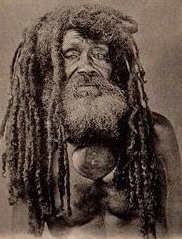
First thing:


...but I soon discovered vampire flesh to be far more complex in flavor. Perhaps it's because the meat has aged longer?
As many of you will probably guess, I do not consider myself a vampire. I do find this site quite delectable, however, despite the fact that many of you are only tolerable marinated in strong seasonings. If that offends you, go have an emo moment. My heart does not bleed for you and I am happy whenever I have a full belly. In my experience there is nothing vampiric that a .45 and some carving cant make dinner-table ready. Speaking of which, I have just returned from a year absence. I was abroad restocking my freezer so I suspect I will have some new tasty recipes for you all shortly. In the meantime, lets review butchering technique (recipes follow):
Butchering the Vampire Carcass for Human Consumption.
Vampires are not generally thought of as a staple food source. Observing the anatomy and skeleton, one can see that the vampire is neither built nor bred for its meat, and as such will not provide nearly as much flesh as a pig or cow (for example, an average 1000 pound steer breaks down to provide 432 pounds of saleable beef). You will not achieve anywhere near such a generous ratio from a vampire. The large central pelvis and broad shoulder blades of the vampire also interfere with achieving perfect cuts. There are advantages to butchering vampires, however, especially due to the fact that the typical specimen will weigh between 100-200 pounds and is easily manipulated by even a small person with sufficient leverage.
Culling the Herd: Here the caution in choosing your meal must be mentioned. It is VERY IMPORTANT to remember that animals raised for slaughter are kept in tightly controlled environments with their health and diet carefully maintained. Vampires are not. Thus not only is the meat of each kill of varying quality, but kills are also subject to an enormous range of diseases, infections, chemical imbalances, and poisonous bad habits, all typically increasing with age. Also as a vampire ages, the meat loses its tenderness, becoming tough and stringy. No farm animal is ever allowed to age for thirty years, much less three hundred. Six to thirteen months old is a more common slaughtering point for domesticated animals. You will obviously want a youthful but mature physically fit vampire in apparently good health. A certain amount of fat is desirable as "marbling" to add a juicy, flavorful quality to the meat.
Workspace: The butcher will need a fairly roomy space in which to work (an interior location IS suggested), and a large table for a butcher's block. A central overhead support will need to be chosen or installed ahead of time to hang the carcass from. Large tubs or barrels for blood and waste trimmings should be convenient, and a water source close by. Most of the work can be done with a few simple tools: sharp, clean short and long bladed knives, a cleaver or hatchet, and a hacksaw.
Body Preparation: Acquiring your vampire is up to you. For best results and health, freshness is imperative. A living vampire in captivity is optimal, but not always available. When possible make sure the vampire has no food for 48 hours, but plenty of water. This fasting helps flush the system, purging stored toxins and bodily wastes, as well as making bleeding and cleaning easier.
Hanging: Once the vampire is unconscious or dead, it is ready to be hoisted. Get the feet up first, then the hands; let the head hang down. This is called the "Gein configuration". Simple loops of rope may be tied around the hands and feet and then attached to a crossbar or overhead beam. Or, by making a cut behind the Achilles tendon, a meathook may be inserted into each ankle for hanging support. The legs should be spread so that the feet are outside the shoulders, with the arms roughly parallel to the legs. This provides access to the pelvis, and keeps the arms out of the way in a ready position for removal. It's easiest to work if the feet are slightly above the level of the butcher's head.

Bleeding: Place a large open vessel beneath the vampire's head. With a long-bladed knife, start at one corner of the jaw and make a deep "ear-to-ear" cut through the neck and larynx to the opposite side. This will sever the internal and external carotid arteries, the major blood vessels carrying blood from the heart to the head, face, and brain. If the vampire is not yet dead, this will kill it quickly and allow for the blood to drain in any case. After the initial rush of blood, the stream should be controllable and can be directed into a receptacle. Drainage can be assisted by massaging the extremities down in the direction of the trunk, and by compressing and releasing, "pumping", the stomach. A mature vampire will contain almost six liters of blood.
Beheading and Trophies*: When the bleeding slows, preparation for decapitation can be started. Continue the cut to the throat around the entire neck, from the jawline to the back of the skull. Once muscle and ligament have been sliced away, the head can be cleanly removed by gripping it on either side and twisting it off, separation occurring where the spinal cord meets the skull. This is indicative of the method to be used for dividing other bones or joints, in that the meat should generally be cut through first with a knife, and the exposed bone then separated with a saw or cleaver.
*The merits of keeping the skull as a trophy are debatable for two principal reasons. First, a vampire skull may call suspicious attention to the new owner. Secondly, thorough cleaning is difficult due to the large brain mass, which is hard to remove without opening the skull. The brain is NOT good to eat and can in fact cause serious disease. Removing the tongue and eyes, skinning the head, and placing it outside in a wire cage may be effective. The cage allows small scavengers such as ants and maggots to cleanse the flesh from the bones, while preventing it being carried off by larger scavengers, such as dogs and children. After a sufficient period of time, you may retrieve the skull and boil it in a dilute bleach solution to sterilize it and wash away any remaining tissue.

Skinning: After removing the head, wash the rest of the body down. Because there is no major market for vampire hides, particular care in removing the skin in a single piece is not necessary, and makes the task much easier. The skin is in fact a large organ, and by flaying the carcass you not only expose the muscular configuration, but also get rid of the hair and the tiny distasteful glands which produce sweat and oil. A short-bladed knife should be used to avoid slicing into muscle and viscera. The skin is composed of two layers, an outer thinner one with a thicker tissue layer below it. When skinning, first score the surface, cutting lightly to be sure of depth and direction. Reflect the skin by lifting up and peeling back with one hand, while bringing the knife in as flat to the skin as possible to cut away connective tissue. You need not bother skinning the hands and feet, these portions not being worth the effort unless you plan to pickle them or use them in soup. The skin can be disposed of, or made into fried rinds. Boil the strips and peel away the outer layer, then cut into smaller pieces and deep-fat fry in boiling oil until puffy and crisp. Dust with garlic salt, paprika and cayenne pepper.
Gutting: The next major step is complete evisceration of the carcass. To begin, make a cut from the solar plexus, the point between the breastbone and stomach, almost to the anus. Be very careful not to cut into the intestines, as this will contaminate the surrounding area with bacteria and possibly feces (if this does happen, cleanse thoroughly). A good way to avoid this is to use the knife inside the abdominal wall, blade facing toward you, and making cautious progress. Make a cut around the anus, or "bung", and tie it off with twine. This also prevents contamination, keeping the body from voiding any material left in the bowel. With a saw, cut through the pubic bone, or "aitch". The lower body is now completely open, and you can begin to pull the organ masses (large and small intestines, kidneys, liver, stomach) out and cut them away from the back wall of the body. For the upper torso, first cut through the diaphragm around the inner surface of the carcass. This is the muscular membrane which divides the upper, or thoracic, and the lower abdominal cavities. Remove the breastbone, cutting down to the point on each side where it connects to the ribs, and then sawing through and detaching it from the collar bone. Some prefer to cut straight through the middle, depending on the ideas you have for cuts in the final stages. The heart and lungs may be detached and the throat cut into to remove the larynx and trachea. Once all of the inner organs have been removed, trim away any blood vessels or remaining pieces of connective tissue from the interior of the carcass, and wash out thoroughly.

Remove the Arms: Actual butchering of the carcass is now ready to begin. Cut into the armpit straight to the shoulder, and remove the arm bone, the humerus, from the collar bone and shoulder blade. Chop the hand off an inch or so above the wrist. Most of the meat here is between elbow and shoulder, as the muscle groups are larger here and due to the fact that there are two bones in the forearm. Another way of cutting this portion is to cut a way the deltoid muscle from the upper arm near the shoulder (but leaving it attached to the trunk) before removing the limb. This decreases the percentage of useable meat on the arm, but allows a larger shoulder strip when excising the shoulder blade. Purely a matter of personal preference. Cut into and break apart the joint of the elbow, and the two halves of each arm are now ready for carving servings from.
Halving the Carcass: The main body is now ready to be split. Some like to saw straight through the spine from buttocks to neck. This leaves the muscle fiber encasing the vertebrae on the end of the ribs. The meat here however is tightly wrapped about the bone, and I find it more suitable (if used at all) when boiled for soup. Thus, my preferred method is to completely remove the entire backbone by cutting and then sawing down either side from the tailbone on through.
Quartering the Carcass: The halves may now be taken down, unless your preparation table or butcher block is very short. This is inadequate, and you will have to quarter while hanging, slicing through the side at a point of your choosing between rib cage and pelvis. Now is also the time to begin thinking a bout how you would like to serve the flesh, as this will determine the style of cuts you are about to make. These will also be greatly affected by the muscular configuration (physical fitness) of your specimen. First, chop the feet off at a point about three inches up from the ankle. The bones are very thick where the leg connects to the foot. You will want to divide the side of meat into two further principal portions: the ribs and shoulder, and the half-pelvis and leg. In between is the "flank" or belly , which may be used for fillets or steaks, if thick enough, or even "bacon" strips if you wish to cut this thinly. Thin and wide strips of flesh may also be rolled, and cooked to serve as a roast. Trim away along the edge of the ribs, and then decide whether you will cut steaks from the flank into the thighs and rump, and carve accordingly.

Cutting the Top Quarter: Although not actually 25% of the meat you will get, this is designated as one-fourth of the carcass as divided into major portions. You may trim away the neck, or leave it to be connected with the shoulder, or "chuck". The first major step with this mass is to remove the shoulder blade and the collar bone. The best and easiest way is to just cut along the outline of the shoulder blade, removing the meat on top and then dislocating the large bone. To excise the collar bone make an incision along its length and then cut and pry it away. Depending upon the development of the breast, you may decide it qualifies as a "brisket" and remove it before cutting the ribs. In the female vampire the breast is composed largely of glands and fatty tissue and, despite its appetizing appearance, is rather inedible.
Cutting the Lower Quarter: This is where most of the meat is, vampires being upright animals. The muscle mass is largest in the legs and rump. The bulk is so comparatively large here that you can do just about anything with it. The main pieces are the buttock or rump and the upper leg, the thigh. Our typical division is to cut the leg off at the bottom of the buttock, then chop away the bony mass of the knee, at places two to three inches away in either direction. Before doing this, however, you may want to remove the whole calf muscle from the back of the lower leg, as this is the best cut in its area. The upper leg is now ready for anything, most especially some beautiful, thick round steaks. The rump will have to be carved from the pelvis in a rather triangular piece. The legs attach at the hip at a forward point on the body, so there will be little interference as you carve along the curve of the pelvis. Remaining meat will be on the thighs in front of the pelvis.
Remember, Vampire flesh should ALWAYS be thoroughly cooked before consumption. So, on to the recipes...

Tonights menu: BLOOD-SUCKER SAUSAGE!!!
First, be careful to kill the vampire using a method that will spill as little of the necessary blood as possible. I suggest an ice-pick to the base of the skull. You may then dress and drain the vampire at your leisure later.
Yield: approximately 10 lbs.
Ingredients:
vampire stock (Not available in stores! Make it early and store in refrigerator)
4 lb meat (thigh, triceps, biceps or gludius maximus)
3 lb liver
3 lb unsmoked bacon (adds fat to the lean vampire meat)
3.5 oz salt
1 T black pepper
3.5 oz onion
1 T dried marjoram
1 pt vampire blood
2 t prague powder #1 (16 oz NaCl : 1 oz NaNO2)
natural casings from the kill
1) Cook the meat in a vampire stock until tender. Save the broth.
2) Grind the meat, liver and bacon through a 1/8 in. or 3/16 in. plate.
3) Add the dry ingredients and mix until evenly distributed.
4) Add the broth and blood and mix thoroughly.
5) Stuff the prepared casings about 15 in. long, leaving 3-4 in. of empty casing on each end. Tie the sausage into a ring.
6) Place the sausage into 170F water. Cook until the internal temperature is 160F.
Enjoy with a dark beer or full bodied merlot. Dinner is served suckers!!

Chauve-Souris au Vin (Bat with Wine)
Often I am asked,"How should I prepare a particularly old vampire"? They can be tough and sinewy its true. At times like these I like to fall back on a traditional French recipe "Chave-Souris au Vin". It will take awhile to cook but it is quite tasty and well worth the effort.

As you can see, the entire vampire will not fit in the stockpot. Just take select cuts and throw the rest to the hounds. You will also need:
Several bottles of wine or brandy.
Button mushrooms if you are going to cook in red wine or brandy.
Morel mushrooms if you are cooking in white wine. I suggest vin jaune.
GARLIC (what can i say...it brings out the flavor in the old ones).
lardons (salt pork).
mirepoix (diced celery, onions, and carrots).
bouquet garni of salt, pepper, thyme, and bayleaf.
It can take quite awhile to breakdown those old sinews and tissues so start early!! The lardons are cut as thin strips and then par-boiled to remove excess salt. They are then sauteed to render out the fat. Then brown off the vampire pieces, adding more oil if needed. The mirepoix is then added along with minced garlic and allowed to briefly cook. Then toss in the bouquet garni along with wine and stock to cover. Mushroom stems and pieces should be added at the beginning of the dish in order to have plenty of time to contribute to the complexity and flavor of the sauce. Near the end of the preparation, the sauce may be strained to remove the cooked vegetables. The sauce is then returned to the vampire and the whole mushrooms and you can add pearl onions for the last fifteen minutes of cooking if you wish. A nice trick for peeling those pesky pearls is to slice off one end and make a shallow "x" cut. Then just pop then in boiling water for a minute and you can pop the right out with a squeeze on the other end.
The juices are thickened either by making a small roux at the beginning of cooking, or, as I prefer, by adding BLOOD at the end.

Bon appetit!
***See the first entry in June, 2010, potions jornal for important note on the above recipe BEFORE cooking this dish. Actually, you should read this entry for important information on cooking with vampire at any time.***
Fanger-Lickin-Good Vampire Ribs
Its the fourth of July so I thought I'd give an update that all patriots could benefit from...RIBS! Thats right, haul out your worst cut of the vampire carcass and fire up the charcoal because its grilling time. Now, where I come from theres always a debate going about which is better, a dry rub or a mopping sauce...I say fuck it, why not both?
Dry Rub:
1/2 cup paprika
3 tablespoons ground black pepper
3 tablespoons coarse salt
3 tablespoons sugar
2 tablespoons chili powder
Moppin sauce:
12 ounces beer
1/2 cup cider vinegar
1/2 cup water
1/4 cup vegetable oil
2 tablespoons Worcestershire sauce
2 tablespoons minced jalapeño chilies
You will also need about 5 lbs. of charcoal and about 4 cups of hickory or oak wood chips soaked in water.
First thing, mix dry rub ingredients in small bowl to blend.
Transfer 1 tablespoon dry rub to another small bowl and reserve for mop. Spread remaining dry rub all over ribs. Cover with plastic; chill overnight. Next, mix wet rub ingredients plus reserved dry rub in heavy medium saucepan. Stir over low heat 5 minutes. Pour 1/2 cup mop into bowl; cover and chill for use in sauce. Cover and chill remaining mop.
Bring smoker up to 200 to 225 F and cover coals with about 1/2 cup of the wood chips. Place the ribs on rack in smoker and cook until tender, about 5-7 hours...or even longer if the vampire was an old tough one. Every 1 1/2 to 2 hours, add enough charcoal to maintain single layer and to maintain 200 - 225 F. temperature; add 1/2 cup drained wood chips. Brush ribs with chilled mop in pan each time smoker is opened. Let rest for a short time before cutting and serving when done. A meal that has been waiting centuries can wait a while longer.
For a quick way of stretching your sauce at the end I'd suggest mixing about a cup of storebought (I like cattlemans)
sauce with a little vinegar and chili powder along with the 1/2 cup of reserved moppin sauce.

The one on the left is pork ribs. The one on the right is dog...yah, lost a hound taking down this vampire, but "waste not want not". At center are the vampire ribs. Yee-haw! Happy fourth yall.
After this, I think I will update only to journal as I dont really want to clutter up the main page...so add it to favorites or some crap like that if you want to read more. Otherwise go to hell for all I care. :P

Honored to have been marked by Assistant Covenmaster XD's coveted Ass.

|

































